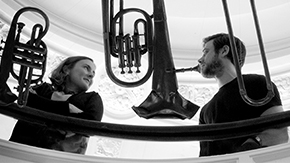Treasures of the Royal Courts: A Rich Chariot
This film presents the English coach given by James I’s ambassador Thomas Smith to Tsar Boris Godunov in 1604. Although the coach was restored in the 1670s, much of the construction, upholstery and embroidery is original and a remarkable survival. This spectacular coach can be found in the Moscow Kremlin Museums.
Video: A Rich Chariot
View transcript of video
In October 1604, this chariot was presented to Tsar Boris Godunov by Thomas Smith, the English ambassador to Muscovy.
It was packed and transported from London via the Arctic Sea to Archangel.
The 11 week journey by land from Archangel to Moscow is shown on this 1562 English map.
It is the earliest surviving printed map of Muscovy.
The coach was assembled in Moscow and driven into the Kremlin.
James I sent his ambassador Thomas Smith to present the gift.
Thomas Smith was a wealthy merchant descended from one of the founders of the Muscovy Company.
The chariot was made in Smithfield, London, by skilled blacksmiths, wheelwrights, carvers, painters and upholsterers.
At the back are the supporters of the royal coat of arms of England.
The lion and the unicorn (now missing its horn).
The double headed eagle represents the Imperial Arms of Muscovy and St George, the patron saint of Moscow.
The undercarriage is constructed like a farm wagon.
The wheels are later 17th-century replacements.
The construction is held together with iron elements, painted and gilded.
The carvings show Muscovite victories.
On the front, Russian Orthodox Christians accompany the Tsar’s chariot in triumphant procession.
On the back, Orthodox Christians fight the Muslim Tatars.
The scenes probably represent victories at Kazan in 1552, and Khan Kazy-Giray in 1591.
The Tatars bear crescent standards and wear turbans.
Scenes of boar, tiger and lion hunts decorate the sides.
Painted scenes show hunting and fishing in rural landscapes.
The upholstered seat, intended for the Tsar and Tsarina of Muscovy, was transferred from another vehicle in the late 17th century.
The canopy posts are covered in cut velvet and fixed with silver headed nails.
The canopy is embroidered in pearls with the Imperial eagle and St George and the Dragon.
An etching by John Dunstall shows a similar coach drawn by six horses.
The coachman is dressed in livery.
The passengers are in mid 17th century dress.
Video: A Rich Chariot - Уникальная английская карета
View transcript of video
В октябре 1604 года эта карета была подарена царю Борису Годунову Томасом Смитом, послом Англии в Москве.
Она была перевезена из Лондона в Архангельск через Арктику.
11-недельное путешествие по суше из Архангельска в Москву показано на этой английской карте 1562 года.
Эта карта - самая ранняя сохранившаяся печатная карта Московского государства.
Экипаж был собран в Москве и перевезен в Кремль.
Для вручения этого подарка Яков I направил своего посла, Томаса Смита.
Томас Смит был состоятельным торговцем и потомком одного из основателей Московской компании.
Карета была изготовлена в лондонском Смитфилде опытными каретных дел мастерами, столярами, шорниками и художниками.
На задней стенке изображены лев и единорог (его рог в настоящее время отсутствует).
Они поддерживают королевский герб Англии.
Позади изображены двуглавый орел - герб Московии и Святой Георгий, - покровитель Москвы.
Подвесная конструкция кареты - без рессор и поворотного круга.
Колеса были заменены позднее, в 17 веке.
Конструкция состоит из металлических позолоченных деталей.
Мотивы деревянного декора изображают победы Московского государства.
На передней стороне кареты изображена триумфальная процессия царя, в сопровождении своих поданных.
На задней стороне православные воины сражаются с татарами-мусульманами.
Эти сцены, вероятно, отражают взятие Казани в 1552 году и победу над Крымским ханом Казы-Гиреем в1591 году.
Татары изображены в тюрбанах, несущими флаги с полумесяцами.
Сцены охоты на борова, тигра и льва украшают боковые стенки.
Кузов кареты украшен живописью с изображением сцен охоты на фоне сельского ландшафта.
Сиденье c обивкой для царя и царицы было перенесено из другого экипажа в конце 17 века.
Стойки крыши, обтянутые бархатом, крепились гвоздиками с серебреными шляпками.
На крыше вышиты жемчугом - двуглавый орел и Святой Георгий Победоносец, борющийся со Змеем.
На гравюре Джона Дансталла показана похожая карета, запряженная шестеркой лошадей.
Кучер одет в ливрею.
Пассажиры— в платьях середины 17 века.


